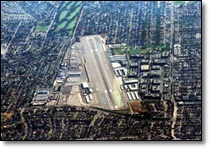 AIN Blog: Goodbye SMO – The general aviation industry in the U.S. lost a key battle last night when the Santa Monica city council voted to impose higher landing fees, not just on transient aircraft but on all aircraft that use the airport. Starting August 1, even a Cessna 172 based at Santa Monica airport (SMO) flown by a local student or rental pilot will be assessed $10.96 for each landing. For training operations, that means a student pilot will end up paying $10.96 for every landing or touch-and-go. A typical business jet flying into SMO, say a Hawker 850XP, will pay $120.56, up from $45.54. Movie actor, airplane and helicopter owner-pilot Harrison Ford, who keeps his fleet at SMO, will be paying a lot more to fly from now on.
AIN Blog: Goodbye SMO – The general aviation industry in the U.S. lost a key battle last night when the Santa Monica city council voted to impose higher landing fees, not just on transient aircraft but on all aircraft that use the airport. Starting August 1, even a Cessna 172 based at Santa Monica airport (SMO) flown by a local student or rental pilot will be assessed $10.96 for each landing. For training operations, that means a student pilot will end up paying $10.96 for every landing or touch-and-go. A typical business jet flying into SMO, say a Hawker 850XP, will pay $120.56, up from $45.54. Movie actor, airplane and helicopter owner-pilot Harrison Ford, who keeps his fleet at SMO, will be paying a lot more to fly from now on.
(CalPilots Editor’s Note: There are abundant monetary resources associated with the aviation community at SMO. It’s time that they organize a legal challenge of the City’s continual harassment of the airport, starting with a complete audit of all aviation related monies collected at SMO. We believe that the the City’s ongoing claim of running in deficit will be proved erroneous once the numbers are reviewed by expertise other than the current anti-airport groups).
The fee change is intended to make up for what the city claims is a consistent budget shortfall for the airport. General aviation advocates disagree about whether that shortfall is accurate, but the city insists that it is real. Anti-airport residents complain not only about what they say is their subsidy of pilots who use the airport but even more vociferously about lead, ultrafine particulate pollution and noise from piston- and turbine-powered aircraft .
I have been flying out of SMO, renting airplanes from a local flight school. When I moved back to California in 2008, I briefly kept my airplane at SMO until I sold it. The airport’s costs were reasonable, only $90 a month for a tiedown, excellent security, no airport squeamishness about me working on my own airplane and a liberal policy allowed me to park my car at my tiedown. The airport is well maintained and a pleasure to fly into.
It’s no secret that the city wants to close the airport. Part of the city council’s resolution at the meeting on April 30 involved recommendations to “continue to assess the potential risk and benefits of closing or attempting to close all or a portion of the airport,” according to the council’s agenda. The city feels that its current agreement with the FAA runs out in 2015 and that big changes may be possible then. And the city said that all leases with airport businesses end in 2015, so expect to see none of those renewed if the city has its way.
Whether or not the city of Santa Monica is able to close the airport or at least shorten the runway by 2,000 feet until it can permanently close the airport (another proposal in the hopper), this new landing fee schedule sets a bad precedent. There are, however, other general aviation airports in the U.S. with similar fees for based aircraft such as Teterboro in northern New Jersey. Owned and operated by the Port Authority of NY & NJ, Teterboro charges all aircraft, including based tenants, fees ranging from $17 for aircraft up to 6,000-pound mtow to $6.50 per thousand pounds for 80,000-pound-plus mtow. This includes a fee for each touch-and-go. The Port Authority’s Newark Airport also charges similar fees, but that is primarily an airline airport. There are no longer any flight schools at Teterboro, which is understandable given the expense of operating there. Republic Airport in Farmingdale, N.Y. charges landing fees to based tenants, including flight schools and for each touch-and-go, and Willow Run Airport in Ypsilanti, Mich. bills based tenants, but only those with an mtow of more than 6,000 pounds.
After the council’s vote last night, I no longer have an incentive to fly out of Santa Monica. This galls me, because I know that’s exactly why the city imposed the new fees. Even though the council members claim that the fees are intended to cover the budget shortfall, we know that what will happen is that fewer pilots will use the airport. And I hate to stop flying from such a great airport, with its rich history and excellent location, just because the city that owns the airport hates it with such passion.
While the city is hoping that flight operations decline at SMO, I predict that plan is going to backfire. Owners and operators who can afford to keep flying at SMO will continue doing so and at a greater rate than before. Jet operations have grown at SMO, and because jet operators are a little more flexible when it comes to added costs, they will likely take up the slack as light airplane operations dwindle. If and until the city actually closes its airport—something the FAA has fought and will fight—the airport is doomed to become a mini-Teterboro.
As for me, I’m going to fly at a nearby airport that welcomes my business. Goodbye SMO.
